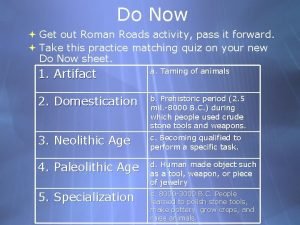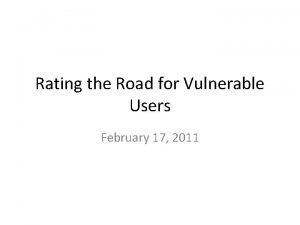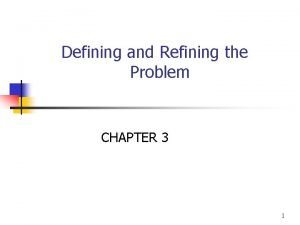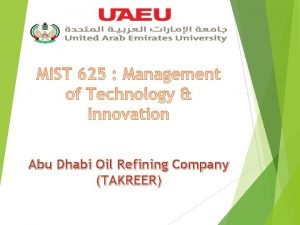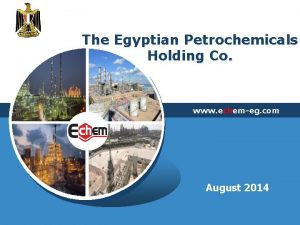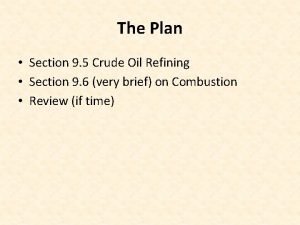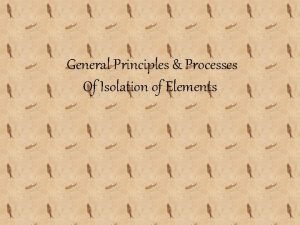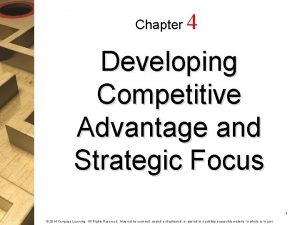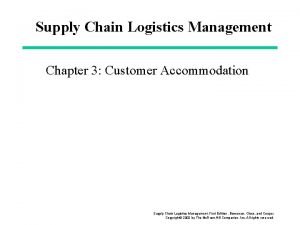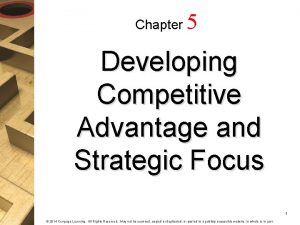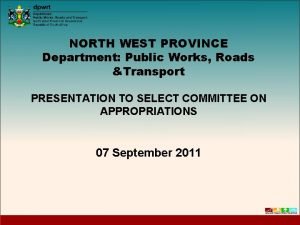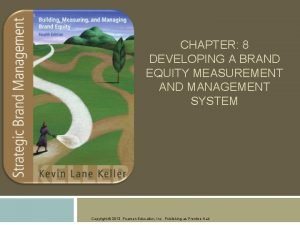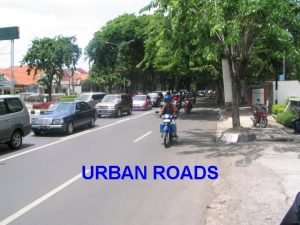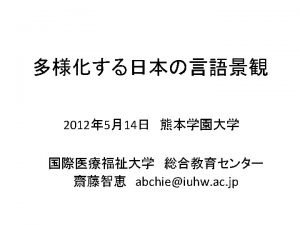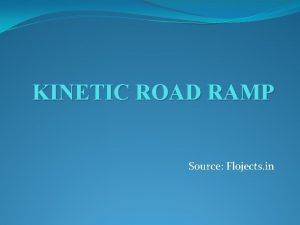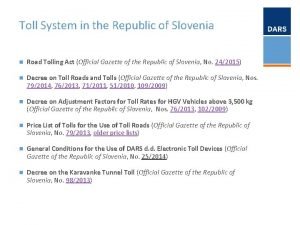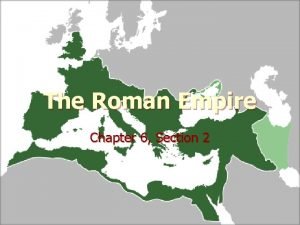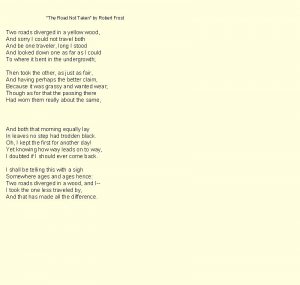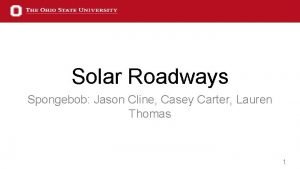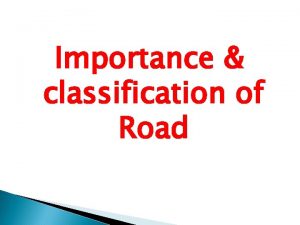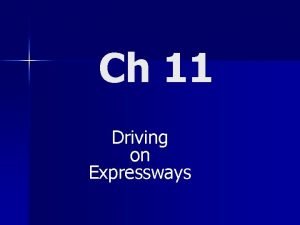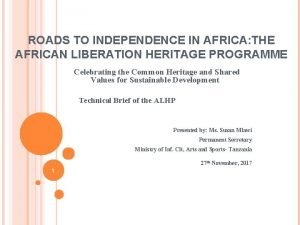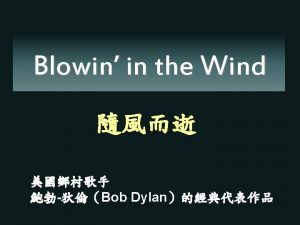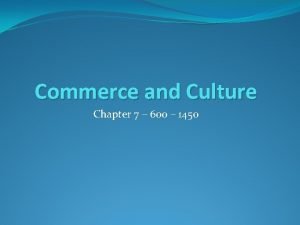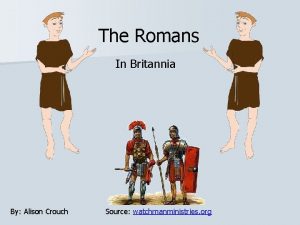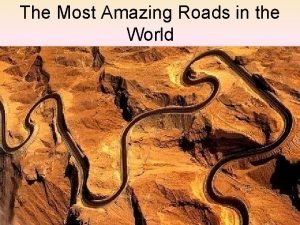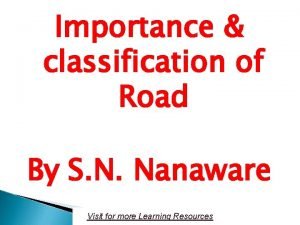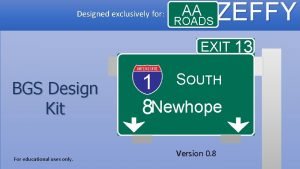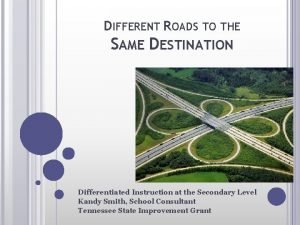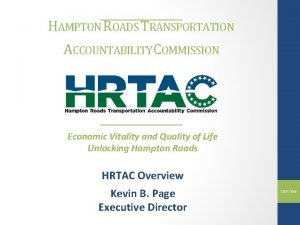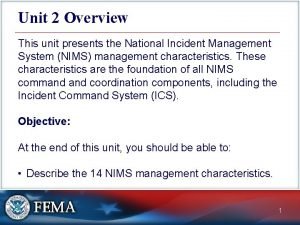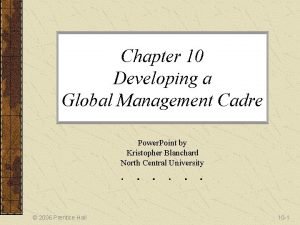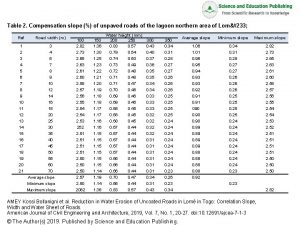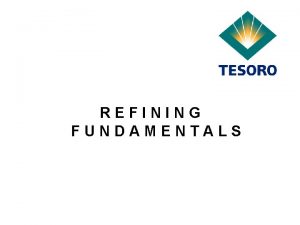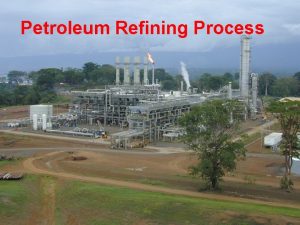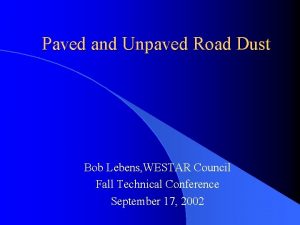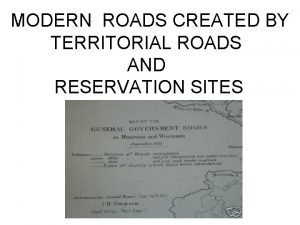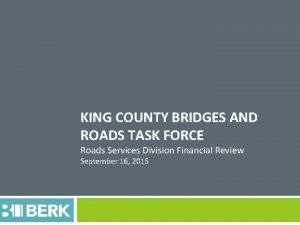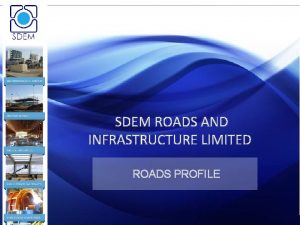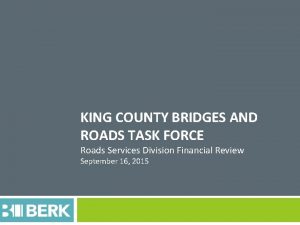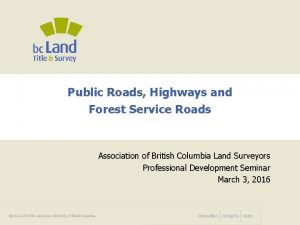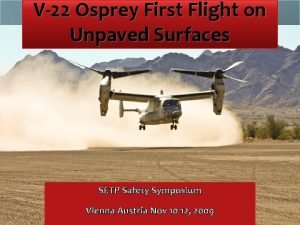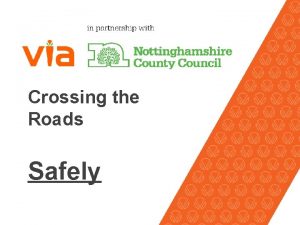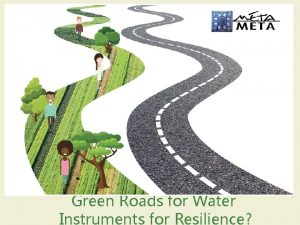MANAGEMENT OF UNPAVED ROADS Developing strategy and refining













































- Slides: 45

MANAGEMENT OF UNPAVED ROADS Developing strategy and refining models SATC Pretoria Mervyn Henderson & Gerrie van Zyl

Acknowledgements and Focus Acknowledgements Mervyn Henderson Western Cape Government District Municipalities Focus Redevelopment of processes and systems for unpaved road maintenance Levels of service for the unpaved road network Demand-supply model for regravelling Materials Information Management System Continuous improvement of maintenance techniques and technologies 1

Background The Western Cape is a province of South Africa & is situated at the southern most part of Africa Area of 129 449 km 2 Bordered by the Atlantic coast on the west & the Indian Ocean in the south A Mediterranean climate Highest elevation 2 325 m 6, 2 million inhabitants About two-thirds of these inhabitants live in the metropolitan area of Cape Town, which is also the provincial capital 2

Introduction – the network The Branch manages the unpaved road network, with the assistance of the five District Municipalities (DMs). The DMs carry out routine maintenance and periodic maintenance, i. e. regravelling. Only a fraction of the gravel loss per annum has been replaced during the last decade – 23 21 22 23 22 22 22 2011 2012 2013 2014 2015 26 2010 30 2009 40 22 20 0 2016 10 2008 Gravel thickness, mm average gravel thickness was approximately 22 mm in 2016 3

Provincial road network Unpaved roads comprise 79% of the road network in the Western Cape – 25 000 km A high proportion of roads with a low traffic volume, only 5% of VKT, 35% of maintenance budget Most unpaved roads fall into traffic categories S 0, S 1, T 0 and T 1 4

Introduction – network condition 5 267 km 50, 8% 3 189 km 30, 7% Good Very Poor 65 Very Good Poor Fair Good 2016 Fair 2015 0% 2014 Poor 2013 20% Very Poor 2012 666 km 6, 4% 2011 61 km 0, 6% 40% 2010 1190 km 11, 5% 60% 2009 80% 2008 Visual condition 2016 100% % of netowk There has been a significant increase in very poor roads since 2013 120% Very Good NCN 2016 2015 2014 2013 2012 2011 45 2010 50 2009 The Network Condition Number has a downward trend 55 2008 NCN 60 Benchmark 5

Feedback from road users “Fasten your bra straps and take out your false teeth. The road is stuffed!” 6

Introduction – objective for unpaved network Imperative that available funding is used in the most effective and efficient manner through application of the best processes and technology for the maintenance of the network. The Branch’s objective for the unpaved road network is “to maintain and build high performance and cost effective gravel roads that will last much longer, provide a good average riding quality and have a safe riding surface, while reducing costs for the road user and the Branch” 7

Introduction - issues Issues contributing to the historically poor performance of the network using unsuitable material lack of an on-site investigation prior to construction full scope of the project not determined addressing only the most serious drainage deficiencies not shaping the roadbed and inadequate compaction inadequate breakdown of the gravel material and poor compaction limited leadership and governance best practice not always applied very few sources were legally compliant leading to a shortage of gravel diversion of funding to the upgrading of unpaved roads, etc. 8

Context of the Gravel Roads Maintenance System 9

Context of the Gravel Roads Maintenance System 10

Strategy development Connecting operational work with strategic objectives – line-of-sight Critical to take a strategic approach and develop a strategy for maintaining unpaved roads in the long term to appropriate standards Strategy content: the vision, project selection process, activity & treatment selection process, principles for decision-making on maintenance treatments, safety requirements, levels of service, guidance on the use of out-of-specification materials and trade-offs involved in using these materials Vision for the unpaved network ‘A network that complies with the targets set for mobility, accessibility and safety, as described by the desired level of service. The Gravel Road Maintenance Management System will be used to support all aspects of the maintenance task’ 11

Level of service Mobility Level of service Intervention Minimum Target Roughness Speed Average [p 90 IRI] [km/h] Roughness Accessibility Days accessible per annum [pa] High 7, 5 80 4 99, 5%: Medium 10 60 5 99%: Low 13 40 6 99%: Very low 15 20 6 99%: In service for ≥ 363 days pa In service for ≥ 361, 5 days pa Safety rating in terms of dustiness Proportion of the unpaved network [km] 3 2 516, 7 4 1 760, 5 4 3 013, 2 5 3 090, 4 12

Activities and treatments The LOS is associated with appropriate work activities and treatments that are constrained by the limited budget Level of service High and Medium Activities and Treatments Blading maintenance Reshape Rework Drainage work Spot regravel Regravel based on priority (economics, social factors and risk) Blading maintenance Reshape only where essential to maintain LOS requirements Drainage work only where essential to maintain LOS Low and Very Low requirements Spot regravel only where essential to maintain LOS requirements 13

Demand-supply model A demand-supply model was developed that models the current demand for gravel using the gravel loss model required supply of gravel regravel teams needed to construct the layer of wearing course Variables Parameters Outputs Traffic Regravelling thickness Quantity of gravel required Weinert N-value (measure of macroclimate) Average thickness of gravel desired on the network Time to reach a steady state thickness of gravel on the network Gradation Number of regravel teams required to sustain the steady state thickness of gravel Plasticity 14

Demand-supply model 80 75 70 65 60 55 50 45 40 35 30 800, 000 700, 000 600, 000 500, 000 400, 000 Avg network Thickness (mm) Gravel applied to network (m 3. pa) Gravel contribution, Thickness, mm Model results for an average gravel thickness of 60 mm and the quantity of material required 300, 000 200, 000 100, 000 0 1 2 3 4 5 6 7 8 9 10 11 12 13 14 15 16 17 18 19 20 Years 15

Scenarios 16

Strategies 17

Resource optimisation system - d. TIMS® Future development will be to customise the Branch’s resource optimisation system (Deighton Total Infrastructure Management System - d. TIMS®) by including the LOS demand-supply model Spreadsheet/ d. TIMS Demand – Supply Optimisation of budget & resources - Budget - Borrow pits - Teams - Manpower - Plant This will enable us to optimise the supply side teams, staff and construction plant for delivering periodic maintenance under a constrained budget 18

Materials Information Management System Material Information Management System Borrow Pit Module Borrow Pit Risk Register Financial Guarantee Module Document Repository Expropriation Module Workflow & communications layer The impact of environmental and mining regulations on the legalisation of gravel sources led to the creation of new functionality in the Materials Information Management System The new business processes supporting the implementation of the mining regulations were documented, & once incorporated in MIMS, this will enable all the processes involved in legalisation of materials sources, including environmental, water, heritage, mining, and financial guarantee approvals to be monitored approval of the rehabilitation of gravel sources and the return of the financial guarantee assist risk assessment and mitigation of risks during the investigation, mining and closure stages of a borrow pit 19

Gravel Road Maintenance Management System Project Management System Tablet/ paper capturing of defects Materials Information Management Tactical Planning Phase Project Scheduling Project Progress Defects Register Defect strip chart Geometric & Structures Designs Blading Optimisation Module Materials Selection & Mix Design - Materials sources - Mix design Network roughness report Gravel Roads Management System Project Scoping, Packaging & Programming, Plant utilisation utility - Project scope - Specifications - Design plans - Treatment plan - Programme of projects Costing System Blading Programme Review Project Risk Register Process & Acceptance Control Cost Report Risks & mitigation measures Reports Gravel Roads Maintenance Management System Layer Quality Project Review Operations Execution Phase 20

Gravel Road Maintenance Management System The registration of projects is controlled by the Branch’s Project Management System Projects are scheduled in the project scheduling module MIMS supplies the Materials Selection and Design module with information on the position of gravel sources, the quantities and quality of the gravel or D binder & processing requirements, enabling the utilisation of gravel for Slippery periodic maintenance to be planned Good (Dusty) A Erodible Ravel & Corrugate C Ravel E B 21

Trade-off between cost, performance and risk A new risk based assessment sheet was developed to assess the trade-offs for the gravels not meeting the specification Factor Climate risk Average cost of material delivered to the road per m 3 Shrinkage Product, Sp Grading coefficient, Gc Performance Classification Categories Wet, temperate, dry High, medium, low By comparison 0 -100, 100 -360, 360 -500 0 -16, 16 -34, 34 -48 A- Erodible, B- ravels & Corrugates, Cravels, D- slippery, E- good Performance Risk (compare deviation of Sp and Gc from category E) CBR of Gravel Wearing Course, % Traffic, AADT % Heavy vehicles Subgrade CBR, % Load spreading risk Hardness, Treton IV Hardness risk Oversize % Oversize risk Cumulative risk High, medium, low <9, 9 -15, >15 <150, 150 -300, >300 5, 5 -10, >10 3, 3 -5, >5 High, medium, low 20, 20 -65, >65 High, medium, low <5, 5 - 10, >10 Low, medium, high L <10, 10 M 14, H>14 Comments and Recommendations 22

Gravel Road Maintenance Management System Project Scoping Defects are assessed and recorded in GROMAMAS The Project Scoping module associates the defects with treatments, such as regravel, spot regravel, reshape, drainage, etc. , or activities, such as cleaning of a pipe culvert A periodic maintenance project is scoped and includes a treatment plan, a costed bill of quantities for projects and details of the utilisation of gravels from the associated gravel sources in MIMS 23

Gravel Road Maintenance Management System The Risk module provides a standard risk profile that covers the investigation, mining and closure of gravel sources, and the operations on the road for periodic maintenance Risk profiles can be adjusted to match the circumstances Mitigation measures are provided The Process and Acceptance Control module is used for quality control and acceptance of the final gravel wearing course Project review is enabled by reports on cost and performance in terms of progress and quality of the final product The risk associated with these factors can be evaluated and mitigation measures implemented Project Review Reports enables the District Roads Engineer to the control scope of work for a project control scheduling control risk with appropriate mitigation measures Assess progress, quality and cost of the work 24

Integration of systems Resource Optimisation System Spreadsheet/ d. TIMS Demand – Supply Optimisation of budget & resources Project Management System Material Information Management System - Budget - Borrow pits - Teams - Manpower - Plant Borrow Pit Risk Register Tablet/ paper capturing of defects Project Progress Defects Register Defect strip chart Financial Guarantee Module Borrow Pit Module Geometric & Structures Designs Tactical Planning Phase Project Scheduling Legend Data flow Output Document Repository Materials Selection & Mix Design - Materials sources - Mix design Project Scoping, Packaging & Programming, Plant utilisation utility - Project scope - Specifications - Design plans - Treatment plan - Programme of projects Workflow & communications layer Network roughness report Gravel Roads Management System Blading Optimisation Module Expropriation Module Costing System Blading Programme Review Project Risk Register Process & Acceptance Control Cost Report Risks & mitigation measures Reports Gravel Roads Maintenance Management System Layer Quality Project Review Operations Execution Phase 25

Improving techniques and technologies Ongoing effort to improve the techniques and technologies of work activities and the monitoring and control of the quality A number of experiments have been set up across all DMs with the objectives of improving maintenance techniques and developing new and/or calibrating robust HDM-4 deterioration models. The scarcity of materials and its effect on maintenance and material specifications with respect to the different levels of service is an ongoing challenge in achieving the best performance Data from the experiments and also data collected on the network will assist in the application of appropriate gravel specifications 26

Blading optimisation The current best practice applied in two Districts and TRH 20 Requires an initial estimate of the blading frequency to maintain the target road roughness set for a selected LOS 27

Blading optimisation process Define network Define Uniform Maintenance sections Feedback Define Minimum & Target LOS Select maintenance strategy – treatment blading type and sequence per section Determine frequency, blade passes, blade km per maintenance section per annum & adjust Unit Costs Appropriate Funding Requirement Fund allocation Determine/ allocate grader productivity per road/ area Combine maintenance sections to obtain balanced distribution per Maintenance Area Distribute blading requirements through year to balance cycles: Blading Schedules Verify monthly program on site & issue Grader/ equipment requirement Recalculate affordable blading frequency per maintenance section Monitor performance 28

Performance models Investigations into different performance models and the ability to calibrate the local conditions and blading type resulted in the selection of the HDM-4 version 2 models The “steady state” of roughness, is a function of traffic material properties climate road geometry blading type and frequency Testing the recommended default values of HDM-4 did not provide acceptable answers, highlighting the need to calibrate the models for local conditions 29

Defining blading methods Due to the high variability in climate and material properties throughout the Western Cape, different blading methods are applied light, dry blading using motorised graders or towed graders heavy, wet blading using normal blades or serrated blades tyre dragging and sand cushioning The applicability and cost-effectiveness of the different methods, currently applied under different conditions, are not defined well enough to establish optimum maintenance strategies 30

Calibrating the HDM-4 model Some factors being investigated for calibration of the HDM-4 model Steady state IRI per Blading Frequency (BF) BF=4 BF=8 BF=12 LOS IRI BF = 24 Time Calibration required for Western cape 31

Crushing of materials The predominant defect is oversized aggregate in the wearing course Two roads were selected where road sections were constructed using material from the same borrow pits to compare the performance of the material processed on the road and the same material crushed to minus 26 mm before it was processed on the road Monitoring these sections over a period of 4 months showed that the crushed material sections could be maintained at an International Roughness Index (IRI) of 1 less than the uncrushed sections with far less effort, i. e. 5 light blades versus 10 heavy blades over the width of the road and at least one less blading per annum At an Average Annual Daily Traffic (AADT) of 150, the savings for the Road Authority amounts to R 10 000 per km per annum and the Vehicle Operating Cost (VOC) savings are R 15 000 per km per annum, giving a total of R 25 000/km pa, or R 250 000/km pa over 10 yr 32

Effect of crushed material 1 IRI extra improvement after blading Cost difference • 5 blades vs 10 blades

Rolling after blading Blade & Roll systems are used in several countries with good results highlighted by different organisations No results could be obtained to quantify the cost-effectiveness of the system Based on a number of experiences in the Western Cape using pneumatic tyred rollers (PTR) for final compaction after regravelling, an experiment was designed to simulate the “blade & roll” system by using a six ton PTR after the wet blading action 3 sections were selected on the same road, but with different material properties Half of each section was rolled after the wet blading activity and the performance in terms of roughness deterioration and gravel loss was measured over periods of 54 and 65 days The intention is to increase the mass of the roller during the follow-up process to quantify the effect of contact stress All three sections showed a slower rate of deterioration in roughness on the rolled sections with the average savings in VOC per vehicle pass 34

Benefit - VOC saving (R/km) Savings in VOC – Rolled versus Not rolling Vehicle passes 35

Effect of rolling on gravel loss 16 Gravel loss (mm) 14 12 10 8 6 4 2 0 0 2, 000 4, 000 6, 000 Vehicle passes Rolled 8, 000 10, 000 Not rolled 36

Tyre dragging 7 road sections have been selected and prepared to compare the effect of tyre dragging with light grader blading on different thicknesses and properties of the sand cushion as well as the rate of roughness deterioration, mainly the formation of corrugations, after treatment Although too early at this stage to report conclusive information, it has been confirmed that the tyre drag, at a cost of less than 40% the cost of light grader blading, is just as effective in the immediate improvement of roughness through removing the loose corrugations The effect of tyre dragging is minimal when hard corrugations have formed 37

Effect of tyre dragging IRI improvement (m/km) 4. 0 Soft corrugations 3. 5 3. 0 2. 5 Hard & soft corrugations 2. 0 1. 5 1. 0 0. 5 Hard corrugations 0. 0 1. 0 2. 0 3. 0 4. 0 5. 0 6. 0 7. 0 8. 0 Distance (km) 38

Blading maintenance strategy development Variability in materials, climatic conditions, topography and traffic volumes require different strategies, i. e. rules for the sequence and frequency of maintenance activities, to maintain a specific LOS at the lowest possible cost The first challenge is to select the “package” and sequence of activities appropriate for a set of conditions, e. g. , very low traffic, dry area, low cohesion materials and high percentage of oversize Incorporating sequential activities such as in-line crushing for reworking, different blading types and reshaping into calibrated performance models for this scenario would assist with determining the required frequency of activities to achieve the minimum and target LOS 39

Construction and maintenance strategies evaluated From previous study Effect of • Reshaping Effect of • Regular light blading Effect of • Material selection • Proper compaction • PTR rolling 40

Example of a maintenance strategy Typically low volume, West coast with availability of sand Minimum LOS Towed/ motorised grading IRI (m/km) Steady state target LOS Tyre dragging Rework/ Regravel Reshaping Time 41

Findings The significance of this work lies in the development of a strategy, which Enables the connection of tactical planning and operational maintenance activities on the unpaved road network with the strategic objectives and Encourages discussion on cost, performance and risk in the time period considered, spurring on improvements that should lead to better network performance HDM-4 performance models can be adjusted and calibrated to incorporate the quality of construction, specific blading methods as well as other treatments The study confirms that the optimum maintenance strategy could consist of • Different treatments during the maintenance life-cycle and • Different strategies are required depending on materials, climate, topography and traffic 42

Conclusions In conclusion, the approach taken by the Branch to develop and implement a turnaround strategy that includes the refinement of HDM 4 prediction models is expected in the medium term to lead to More effective management Better network performance Improved outcomes for the community 43

Cape Town and Table Mountain Thank you! 44
 Modern roads vs roman roads venn diagram
Modern roads vs roman roads venn diagram What is paved and unpaved road
What is paved and unpaved road Unpaved median strip
Unpaved median strip Data management roadmap
Data management roadmap Defining and refining the problem ppt
Defining and refining the problem ppt Abu dhabi oil refining company
Abu dhabi oil refining company Egyptian petrochemicals holding company
Egyptian petrochemicals holding company Refining discussion techniques
Refining discussion techniques Crude oil refining process
Crude oil refining process Short note on vapour phase refining
Short note on vapour phase refining Developing competitive advantage and strategic focus
Developing competitive advantage and strategic focus Customer accommodation in supply chain management
Customer accommodation in supply chain management Developing a firms strategy canvas focuses on
Developing a firms strategy canvas focuses on Public works north west
Public works north west How did land grants and new roads affect brazil?
How did land grants and new roads affect brazil? Brand equity responsibilities
Brand equity responsibilities Ancient china zhou dynasty
Ancient china zhou dynasty Roadside friction
Roadside friction Billboards
Billboards Electro kinetic road ramp
Electro kinetic road ramp Battle of hampton roads map
Battle of hampton roads map Slovenia toll roads
Slovenia toll roads Chapter 6 section 2 the roman empire answer key
Chapter 6 section 2 the roman empire answer key Robert frost two roads diverged in a yellow wood
Robert frost two roads diverged in a yellow wood Spongebob roads
Spongebob roads Classification of nagpur road plan
Classification of nagpur road plan How many must a man walk down
How many must a man walk down Why are expressways safer than other types of roads
Why are expressways safer than other types of roads Roads to independence
Roads to independence Road leading to rome
Road leading to rome How many roads must a man
How many roads must a man What are the objectives of highway geometric design
What are the objectives of highway geometric design What lay behind the flourishing of indian ocean commerce
What lay behind the flourishing of indian ocean commerce Sea roads as a catalyst for change southeast asia
Sea roads as a catalyst for change southeast asia Source
Source Most amazing roads in the world
Most amazing roads in the world Classification of roads by nagpur road plan
Classification of roads by nagpur road plan Ideality roads
Ideality roads Aa roads forum
Aa roads forum Lateral thinking riddle
Lateral thinking riddle Many roads lead to the same destination
Many roads lead to the same destination Roman roads research association
Roman roads research association Hampton roads transportation accountability commission
Hampton roads transportation accountability commission We are catfish for dinner figurative language
We are catfish for dinner figurative language Depending on the incident size and complexity
Depending on the incident size and complexity Developing a global management cadre
Developing a global management cadre
